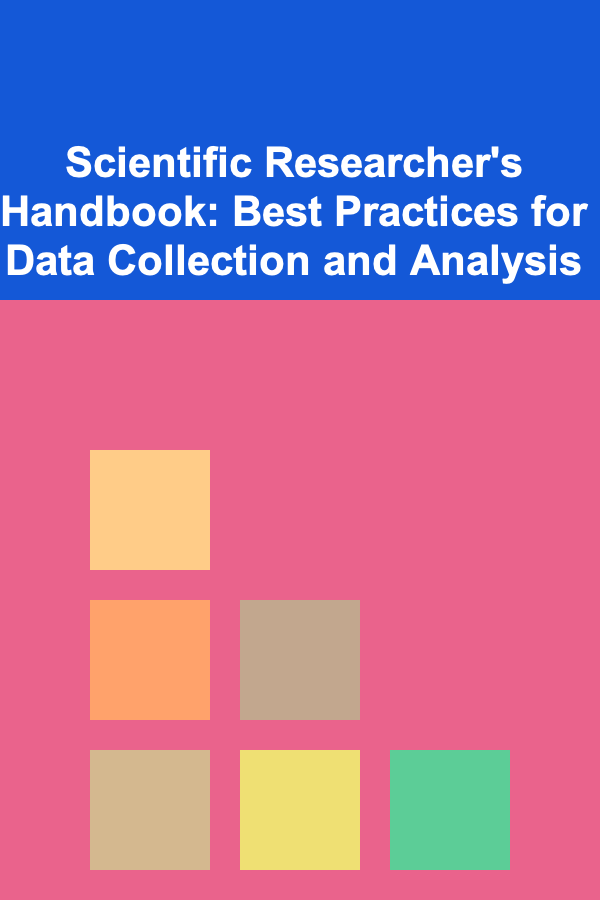
Scientific Researcher's Handbook: Best Practices for Data Collection and Analysis
ebook include PDF & Audio bundle (Micro Guide)
$12.99$5.99
Limited Time Offer! Order within the next:

Scientific research relies heavily on the integrity, accuracy, and depth of data collection and analysis. Whether you're conducting experiments, performing surveys, or gathering observational data, how you collect and analyze data fundamentally shapes the outcome and reliability of your research. A methodologically sound and rigorous approach to data ensures that your findings are credible, reproducible, and capable of contributing meaningfully to the scientific community.
This actionable guide is designed to help researchers navigate the complexities of data collection and analysis. It will provide detailed steps, best practices, and key considerations that will help you obtain high-quality data and analyze it with precision.
Data Collection: Laying the Foundation
Effective data collection is the cornerstone of high-quality research. To ensure the data you gather is accurate, reliable, and relevant to your research questions, follow these key principles:
1. Define Clear Research Objectives and Questions
Before collecting any data, you must first define the research objectives and the specific questions you intend to answer. This step serves as the foundation for your entire research project.
- Refine Research Questions: Ensure that your research questions are clear, focused, and testable. A well-defined question directs your data collection efforts and helps you identify the variables that need to be measured.
- Hypothesis Formation: Based on your research questions, formulate hypotheses that are specific and measurable. Your hypotheses will guide the type of data you collect, the methods you use, and the way you analyze the data.
2. Choose the Right Data Collection Method
Selecting the appropriate data collection method depends on your research objectives, the nature of your study, and available resources. Common methods include:
- Quantitative Methods : These methods collect numerical data that can be analyzed using statistical techniques. Examples include experiments, surveys with close-ended questions, and sensor data.
- Best Practice: Ensure that your quantitative methods are reliable (repeatable results) and valid (measuring what you intend to measure). Use standardized instruments, like validated surveys or well-calibrated sensors, to ensure consistency.
- Qualitative Methods : These methods gather non-numerical data that can provide rich insights into participants' experiences, attitudes, or behaviors. Examples include interviews, focus groups, and observational research.
- Best Practice: Maintain an open, unbiased approach during data collection. Use well-structured interview guides or coding schemes to maintain consistency across interviews and observations.
- Mixed Methods : A combination of both quantitative and qualitative methods can provide a more comprehensive understanding of the research question. These methods are particularly useful for addressing complex or multifaceted problems.
- Best Practice: Ensure that the integration of quantitative and qualitative data is well-planned and that both types of data contribute to answering the research question.
3. Sample Size and Selection
Choosing the correct sample size and method of selection is essential for ensuring that your data is representative and provides valid results.
-
Statistical Power: Ensure that your sample size is large enough to detect meaningful effects. Conduct a power analysis before beginning data collection to determine the required sample size.
-
Sampling Method: Choose an appropriate sampling technique based on your research design. Random sampling minimizes bias, while stratified sampling ensures that specific subgroups are adequately represented in your data.
- Best Practice: Avoid convenience sampling unless there are clear limitations. Non-random samples may introduce bias, leading to results that are not generalizable.
4. Data Quality Assurance
Maintaining high data quality is crucial to ensuring the accuracy and reliability of your results.
- Pilot Testing : Before starting full-scale data collection, conduct a pilot test to identify potential issues with your data collection methods, tools, or processes.
- Best Practice: Analyze the pilot data to check for inconsistencies, flaws, or ambiguities in your research instruments, and make adjustments as needed.
- Training and Calibration: Ensure that everyone involved in the data collection process is properly trained. If you're using measurement tools, ensure they are calibrated properly to avoid measurement errors.
- Data Recording and Storage : Adopt a clear and consistent approach for recording and storing data. Use electronic formats that are easy to organize, back up, and secure.
- Best Practice: Use cloud storage or external hard drives for backup and ensure that data is encrypted if it contains sensitive information.
Data Analysis: Turning Raw Data into Meaningful Insights
Once data has been collected, the next step is analyzing it in a way that allows you to draw conclusions and answer your research questions. Analyzing data involves selecting the appropriate techniques, interpreting the results, and ensuring that conclusions are well-supported by evidence.
1. Clean and Prepare the Data
Data cleaning and preparation are essential for ensuring that the dataset is accurate, consistent, and free from errors.
- Handling Missing Data : Missing data can distort your analysis and lead to biased conclusions. Depending on the extent and nature of the missing data, you can either omit it, use imputation methods, or apply statistical techniques to account for it.
- Best Practice: Always document your approach to handling missing data to ensure transparency and reproducibility.
- Outlier Detection : Outliers can sometimes indicate errors in data collection or genuinely unusual events. It is important to investigate outliers to determine whether they are valid data points or should be excluded.
- Best Practice: Use statistical techniques (such as z-scores or interquartile range) to detect and assess outliers systematically.
2. Choose the Right Analytical Approach
Selecting the correct analytical method depends on your research question, the nature of your data, and the hypotheses you are testing.
- Descriptive Analysis : This method summarizes data through measures of central tendency (mean, median, mode) and measures of variability (standard deviation, range).
- Best Practice: Use descriptive statistics to provide a clear summary of your dataset, but remember that they do not offer explanations or inferences about causality.
- Inferential Statistics : These methods allow you to make generalizations about a population based on sample data. Common techniques include t-tests, chi-square tests, ANOVA, and regression analysis.
- Best Practice: Ensure that your data meets the assumptions of the statistical test you are using (e.g., normality, homogeneity of variance). Misapplication of tests can lead to incorrect conclusions.
- Qualitative Data Analysis : If your data is qualitative, coding and thematic analysis are often used to identify patterns, themes, or categories.
- Best Practice: Use software tools like NVivo or MAXQDA to organize, code, and analyze large qualitative datasets. Engage in a systematic process to reduce researcher bias in coding.
3. Model Your Data
For more advanced analyses, especially in fields like physics, economics, and social sciences, modeling data can provide deeper insights.
- Regression Analysis : Linear and nonlinear regression models are used to understand relationships between dependent and independent variables. These methods can help identify predictive factors and quantify relationships.
- Best Practice: Use proper model diagnostics (such as residual analysis) to ensure that the model fits the data appropriately.
- Machine Learning Techniques : For large or complex datasets, machine learning methods like classification, clustering, and decision trees can be valuable. These techniques automatically detect patterns and relationships within the data.
- Best Practice: Split your data into training and test sets to validate the model and prevent overfitting.
4. Interpret Results with Caution
Once you've completed your analysis, interpreting the results accurately is crucial. Here are some considerations:
- Contextualize Findings: Always interpret results within the context of your research question and the existing literature. Look for patterns and relationships that support or challenge existing theories.
- Statistical Significance vs. Practical Significance : A result may be statistically significant but not practically meaningful. Consider both statistical significance (e.g., p-values) and the effect size when drawing conclusions.
- Best Practice: Report both p-values and effect sizes to provide a fuller picture of the research findings.
- Avoid Cherry-Picking: Ensure that all results, both positive and negative, are reported honestly. Selective reporting or data manipulation can damage your credibility and the integrity of the research community.
5. Validate Your Findings
Replicability and validation are core principles of scientific research. Always take steps to validate your findings, either by replicating the study or seeking external validation.
- Cross-Validation : In statistical modeling, cross-validation is used to evaluate the generalizability of the model on new, unseen data.
- Best Practice: Use cross-validation to assess the stability and accuracy of your model, especially in predictive analyses.
- Peer Review and Collaboration: Collaboration with colleagues and peers can help identify flaws in your analysis or alternative interpretations of your findings.
Conclusion
Data collection and analysis are two of the most critical aspects of scientific research. By following best practices in both areas, you can ensure that your findings are both valid and reliable. In particular, it is essential to maintain a disciplined and systematic approach to data collection, use appropriate statistical and analytical techniques, and interpret your findings with rigor and caution.
By adhering to the guidelines outlined in this handbook, you will be well-equipped to produce high-quality, impactful research that contributes to the advancement of knowledge in your field. Successful data collection and analysis don't just ensure the accuracy of your results; they foster the integrity of the scientific process itself.

Becoming a Successful Account Executive: Essential Skills for Closing Deals
Read More
How to Build a Pet-Friendly Mudroom for Dirty Paws
Read More
How to Choose the Best Tools for Virtual Collaboration
Read More
How to Make Your Bedroom Feel Luxurious Without a High Price Tag
Read More
How to Optimize VR Performance
Read More
How to Organize Your Travel Photos for Easy Sharing
Read MoreOther Products

Becoming a Successful Account Executive: Essential Skills for Closing Deals
Read More
How to Build a Pet-Friendly Mudroom for Dirty Paws
Read More
How to Choose the Best Tools for Virtual Collaboration
Read More
How to Make Your Bedroom Feel Luxurious Without a High Price Tag
Read More
How to Optimize VR Performance
Read More